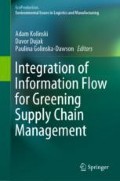Abstract
Systematic growth of cargo flow in the TEN-T corridor passing through the all Sea Ports served both by the existing terminals and those planned in the Port’s development strategy. The forecast growth rate of turnover in the Port results from the strategy adopted by the Port Authority to increase competitiveness and attractiveness of the Port as a business partner, in response to the implementation of the strategy of economic development of Europe, the strategy of development of the New Silk Belt and Route China-Europe and the dynamic development of European import/export. Currently, traffic in the European Sea Ports (e.g. Rotterdam, Hamburg, Antwerp, Dover, Felixstowe, Aalborg, Le Havre, Lisbon) periodically reaches the saturation level in the existing road network. This causes, periodically and in the perspective of the development of goods turnover, the reasons for this:
-
lorry queues before entering terminals and on access roads, creating traffic jams and blocking roads in the Port and City and the main access routes,
-
extension of unloading/loading time of ships,
-
reducing the efficiency and effectiveness of terminals’ work,
-
inefficient use of parking lots in the port, as well as in the period of traffic jams when there are no parking spaces for lorries in the port’s parking lots and its surroundings,
-
reduction of traffic safety and greater susceptibility to collisions with high or critical saturation of traffic in the road network and reduction of transport comfort for the society of the port agglomeration.
The problems identified have a significant impact on the efficiency and duration (and delays) of cross-border road freight transport (road hauliers from all over Europe), in global maritime supply chains served by global shipping lines, as well as in international rail freight transport.
Access this chapter
Tax calculation will be finalised at checkout
Purchases are for personal use only
Notes
- 1.
Road capacity—the largest number of motor vehicles that can pass through a given cross-section of a road or lane in one direction (for two-way roads in both directions) per hour in favourable weather conditions. The throughput is expressed in real vehicles per hour [P/h].
- 2.
Free-Road Level (FRL) is a qualitative measure of traffic conditions, taking into account the feelings of drivers and other road users. The whole range of variability of traffic conditions is divided into 6 classes—marked with the letters A–F. The level of freedom of movement A corresponds to the best, and FRL F to the worst traffic conditions. The level of freedom E determines the traffic intensity corresponding to the road throughput.
References
Greer L, Fraser JL, Hicks D, Mercer M, Thompson K (2018) Intelligent transportation systems benefits, costs, and lessons learned: 2018 update report (No. FHWA-JPO-18-641). United States. Department of Transportation. ITS Joint Program Office
HCM (2010) Highway capacity manual. Transportation Research Board of National Academies, Washington
Kolinski A, Jaskolska E (2018) Analysis of the information flow efficiency in the intermodal supply chain-research results. Bus Logistics Mod Manage 135–155
Meneguette RI, Robson E, Loureiro AA (2018) Intelligent transport system in smart cities. Springer International Publishing, Basel
Pedersen JT (2012) One common framework for information and communication systems in transport and logistics: facilitating interoperability. In: Go-linska P, Hajdul M (eds) Sustainable transport. Springer, Berlin, pp 165–196
Prajogo D, Olhager J (2012) Supply chain integration and performance: the effects of long-term relationships, information technology and sharing, and logistics integration. Int J Prod Econ 135(1):514–522
Sliwczynski B, Hajdul M, Golinska P (2012) Standards for transport data ex-change in the supply chain–pilot studies. In: KES international symposium on agent and multi-agent systems: technologies and applications. Springer, pp 586–594
Speier C, Mollenkopf D, Stank TP (2008) The role of information integration in facilitating 21(st) century supply chains: a theory-based perspective. Transp J 47(2):21–38
Wagener N (2017) Intermodal logistics centres and freight corridors—concepts and trends. LogForum 13(3):273–283
Wong CW, Lai KH, Cheng TCE, Lun YV (2015) The role of IT-enabled collaborative decision making in inter-organizational information integration to improve customer service performance. Int J Prod Econ 159:56–65
Zhang J, Wang FY, Wang K, Lin WH, Xu X, Chen C (2011) Data-driven intelligent transportation systems: a survey. IEEE Trans Intell Transp Syst 12(4):1624–1639
Author information
Authors and Affiliations
Corresponding author
Editor information
Editors and Affiliations
Rights and permissions
Copyright information
© 2020 Springer Nature Switzerland AG
About this chapter
Cite this chapter
Sliwczynski, B. (2020). Value of ICT Integration Model of e-Booking System and Intelligent Truck Traffic Management System in the Sea Port of TEN-T Corridor. In: Kolinski, A., Dujak, D., Golinska-Dawson, P. (eds) Integration of Information Flow for Greening Supply Chain Management. EcoProduction. Springer, Cham. https://doi.org/10.1007/978-3-030-24355-5_14
Download citation
DOI: https://doi.org/10.1007/978-3-030-24355-5_14
Published:
Publisher Name: Springer, Cham
Print ISBN: 978-3-030-24354-8
Online ISBN: 978-3-030-24355-5
eBook Packages: Earth and Environmental ScienceEarth and Environmental Science (R0)

